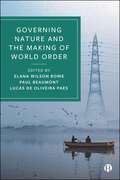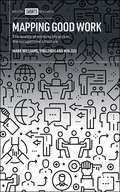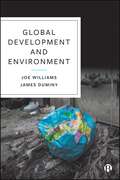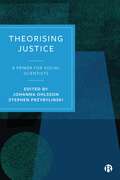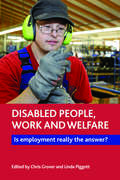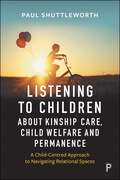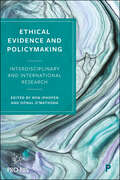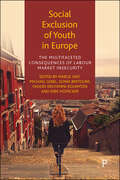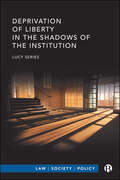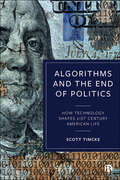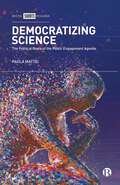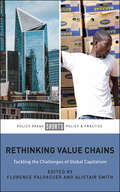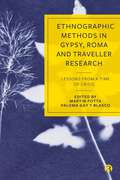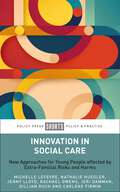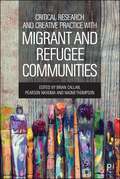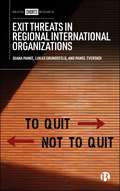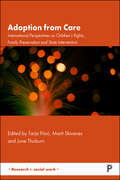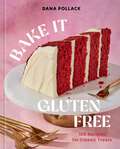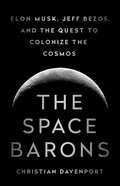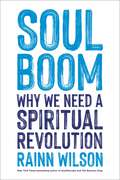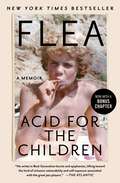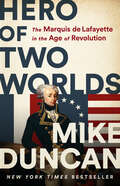- Table View
- List View
Governing Nature and the Making of World Order
by Elana Wilson Rowe, Paul Beaumont and Lucas de Oliveira PaesAvailable open access digitally under CC-BY-NC-ND licence. How have efforts to govern nature and address urgent global environmental challenges shaped, transformed or undermined processes of world ordering? Chapters in this book explore how efforts to govern nature have transformed – or are transforming – how we understand and practice world politics. Bringing together a team of contributors from around the world, the book traces this inquiry across diverse international policy fields, from security and peacebuilding through science cooperation and governing ecosystems to the politics of economic growth. Taken together, the book offers a conceptually ambitious and empirically grounded account of how the governance of nature and the making of world order intertwine and calls for a research agenda to attend to the growing impact of this interrelationship.
Mapping Good Work: The Quality of Working Life Across the Occupational Structure
by Mark Williams Ying Zhou Min ZouAvailable Open Access under CC-BY-NC-ND licence In this enlightening study of modern working lives in Britain, leading experts on the sociology of work draw on detailed statistical analyses to assess job quality and job satisfaction. Drawing on decades of research data on hundreds of occupational groups, the authors challenge conventional notions of ‘good work’ and consider them afresh through the lens of workers themselves. With examples from many professions, the book examines why some occupations feel more rewarding than others, regardless of factors like pay and security. Exploring fresh policies to promote the agenda for fulfilling employment, it builds an important case for genuine and sustained satisfaction in working lives.
Global Development and Environment
by Joe Williams James DuminyAvailable open access digitally under CC-BY licence. Development and environmental challenges are often framed at the global or planetary scale, but in a vague or apolitical manner. This book develops a theoretically rigorous and politicized concept of the planetary to intervene in contemporary debates on global development and to enhance our critical understanding of development as we approach the second quarter of the twenty-first century. Chapters explore key themes and processes including urbanization, demographic change, health, financialization, and infrastructure development. Referencing diverse cases and examples drawn from across the world, the book argues that the futures of global development are inseparable from environmental challenges and transformations.
Theorising Justice: A Primer for Social Scientists
by Johanna Ohlsson and Stephen PrzybylinskiAvailable Open Access digitally under CC-BY-NC-ND licence. Bringing together divergent approaches to justice theorising, this volume connects normative and philosophical theories with the more empirically focused approaches emerging today in the social and political sciences and policy scholarship. The chapters overview a variety of mainstream approaches and radical critiques of justice to illustrate their value in addressing the pressing problems of climate change and economic development. Stressing the value of assessing justice theories in light of the material conditions of our changing world, the book concludes with an in-depth synthesis of how these wide ranging approaches to justice will be useful for students, scholars and practitioners concerned with realising justice.
Disabled People, Work and Welfare: Is Employment Really the Answer?
by Chris Grover and Linda PiggottEPUB and EPDF available Open Access under CC-BY-NC-ND licence. This is the first book to challenge the concept of paid work for disabled people as a means to ‘independence’ and ‘self determination’. Recent attempts in many countries to increase the employment rates of disabled people have actually led to an erosion of financial support for many workless disabled people and their increasing stigmatisation as ‘scroungers’. Led by the disability movement’s concern with the employment choices faced by disabled people, this controversial book uses sociological and philosophical approaches, as well as international examples, to critically engage with possible alternatives to paid work. Essential reading for students, practitioners, activists and anyone interested in relationships between work, welfare and disability.
Listening to Children about Kinship Care, Child Welfare, and Permanence: A Child-Centred Approach to Navigating Relational Spaces
by Paul Daniel ShuttleworthFor too long, kinship and other forms of childhood care have been determined without a clear focus on children’s views. This book unveils unique research on the transformative power of listening to children, exploring how they navigate family life and relationships. It offers fresh insights for theories, policies and practices in support of children’s welfare. Essential reading for academics, researchers, practitioners and families, this book champions a new critical realist "what matters" approach, reinvigorating kinship care and child permanence debates.
Ethical Evidence and Policymaking: Interdisciplinary and International Research
by Ron Iphofen and Dónal O’MathúnaEPDF and EPUB available Open Access under CC-BY-NC-ND licence. This important book offers practical advice for using evidence and research in policymaking. The book has two aims. First, it builds a case for ethics and global values in research and knowledge exchange, and second, it examines specific policy areas and how evidence can guide practice. The book covers important policy areas including the GM debate, the environment, Black Lives Matter and COVID-19. Each chapter assesses the ethical challenges, the status of evidence in explaining or describing the issue and possible solutions to the problem. The book will enable policymakers and their advisors to seek evidence for their decisions from research that has been conducted ethically and with integrity.
Social Exclusion of Youth in Europe: The Multifaceted Consequences of Labour Market Insecurity
by Marge Unt, Michael Gebel, Sonia Bertolini, Vassiliki Deliyanni-Kouimtzi, and Dirk HofäckerEPDF and EPUB available Open Access under CC-BY-NC-ND licence. Policymakers throughout Europe are enacting policies to support youth labour market integration. However, many young people continue to face unemployment, job insecurity, and the subsequent consequences. Adopting a mixed-method and multilevel perspective, this book provides a comprehensive investigation into the multifaceted consequences of social exclusion. Drawing on rich pan-European comparative and quantitative data, and interviews with young people from across Europe, this text gives a platform to the unheard voices of young people. Contributors derive crucial new policy recommendations and offer fresh insights into areas including youth well-being, health, poverty, leaving the parental home, and qualifying for social security.
Deprivation of Liberty in the Shadows of the Institution (Law, Society, Policy)
by Lucy SeriesePDF and ePUB available Open Access under CC-BY-NC licence. During the 20th century the locus of care shifted from large institutions into the community. However, this shift was not always accompanied by liberation from restrictive practices. In 2014 a UK Supreme Court ruling on the meaning of ‘deprivation of liberty’ resulted in large numbers of older and disabled people in care homes, supported living and family homes being re-categorized as ‘detained’. Placing this ruling in its social, historical and global context, this book presents a socio-legal analysis of social care detention in the post-carceral era. Drawing from disability rights law and the meanings of ‘home’ and ‘institution’ it proposes solutions to the Cheshire West ruling’s paradoxical implications.
Algorithms and the End of Politics: How Technology Shapes 21st-Century American Life
by Scott TimckeEPDF and EPUB available Open Access under CC-BY-NC-ND licence. As the US contends with issues of populism and de-democratization, this timely study considers the impacts of digital technologies on the country’s politics and society. Timcke provides a Marxist analysis of the rise of digital media, social networks and technology giants like Amazon, Apple, Facebook and Microsoft. He looks at the impact of these new platforms and technologies on their users who have made them among the most valuable firms in the world. Offering bold new thinking across data politics and digital and economic sociology, this is a powerful demonstration of how algorithms have come to shape everyday life and political legitimacy in the US and beyond.
Democratizing Science: The Political Roots of the Public Engagement Agenda
by Paola MatteiAvailable open access under CC-BY-NC-ND licence. Public trust in the scientific community is under extraordinary pressure. Crucial areas of human activity and public policy, such as education, universities, climate and health care are influenced by populist political strategies rather than evidence-based solutions. Moreover, data-driven methods are becoming increasingly subject to delegitimization. This book examines potential remedies for improving public trust and the legitimacy of science. It reviews different policy approaches adopted by governments to incentivize the empowerment of stakeholders through co-production arrangements, participatory mechanisms, public engagement and interaction between citizens and researchers. Offering an original analysis of the political roots of the governmental impact and engagement agenda, this book sheds much-needed light on the wider connections to democracy.
Rethinking Value Chains: Tackling the Challenges of Global Capitalism
by Florence PalpacuerEPUB and EPDF available Open Access under CC-BY-NC-ND licence. Today, production processes have become fragmented with a range of activities divided among firms and workers across borders. These global value chains are being strongly promoted by international organisations, such as the World Bank and the World Trade Organization, but social and political backlash is mounting in a growing variety of forms. This ambitious volume brings together academics and activists from Europe to address the social and environmental imbalances of global production. Thinking creatively about how to reform the current economic system, this book will be essential reading for those interested in building sustainable alternatives at local, regional and global levels.
Ethnographic Methods in Gypsy, Roma and Traveller Research: Lessons from a Time of Crisis
by Martin Fotta and Paloma Gay y BlascoEPDF and EPUB available Open Access under CC-BY-NC-ND licence. This collection scrutinizes the methodological and ethical challenges that researchers face when working with and for Gypsy, Roma and Traveller communities in the context of global crises. Contributors assess the impact of the pandemic on their engaged research, evaluating novel methods and technologies. They reveal how current research practice blurs the borders between activism and scholarship, and they argue the need for innovative collaborations with local communities. Showcasing emerging aspects of GRT-related scholarship, this book makes a key contribution to larger debates on the positionality of researchers and the politics of research, and affirms the continued value of rigorous ethnography.
Climate Technology and Law in the Anthropocene
by Leonie Reins and Alexander ZaharAvailable open access digitally under CC-BY-NC-ND licence. As climate change accelerates, our window for action is closing. To stay within the "Anthropocene" - an epoch in which humankind as the dominant force shaping the planet retains a degree of control over the destructive processes it has unleashed - global warming must be kept below 2° Celsius. This book explores the unprecedented technological and legal changes required to achieve this. Featuring contributions from leading experts, the essays examine the intersection of technology, law, and environmental values, offering diverse viewpoints on navigating the Anthropocene. Revealing the controversies of rapid technological adoption and legal reform, this is a crucial analysis of a complex future whose many dangers for our society are barely understood.
Innovation in Social Care: New Approaches for Young People Affected by Extra-Familial Risks and Harms
by Nathalie Huegler Gillian Ruch Carlene Firmin Jenny Lloyd Michelle Lefevre Rachael Owens Jeri DammanAvailable open access under CC-BY-NC-ND licence. Based on the findings of the Innovate Project, a four year pan-UK study to identify the processes of innovation in care, this book asks: how can services be re-envisioned and transformed through innovation? The authors provide an overview of the project findings and offer insights into the core conditions necessary for socially just and practice-congruent social care innovation that responds to the distinctive, contemporary safeguarding concerns facing young people. Essential reading for anyone engaged in social care practice and innovation, as well as those undertaking continuing professional development, this book will aid the reader in developing a conceptual understanding of their experiences and support them in designing more informed responses to the challenges they face.
Critical Research and Creative Practice with Migrant and Refugee Communities: Towards interventions based on practice research and community voices
by Brian Callan, Pearson Nkhoma and Naomi ThompsonEPUB and EPDF available Open Access under CC-BY-NC-ND licence. Drawing on the voices and experiences of refugees, activists and professional practitioners, this collection illustrates the complexities of migration with real world case studies, and the possibilities of innovative and compassionate interventions. Highlighting the use of creative and narrative methods in the social, therapeutic and community sectors, all chapters provide clear practice implications. Rather than presenting migration as a problem to be avoided, this book offers original insights on how research and practice can be better informed by the voices of those seeking a better way.
Exit Threats in Regional International Organizations
by Diana Panke Lukas Grundsfeld Pawel TverskoiAvailable open access digitally under CC-BY-NC-ND licence. This book offers a comprehensive analysis of why and when member states threaten to withdraw from regional international organizations (RIOs). A unique dataset covers over 120 exit threats across RIOs from all world regions. The book explains variation as a result of limited specific and diffuse support, such as the inability to exert influence or prevail under majority decision-making, as well as a lack of democratic socialization. With nationalism and populism on the rise, this timely study unpacks crucial pressure points in international institutions, offering invaluable insights into how they can maintain stability in the face of internal contestations.
Adoption from Care: International Perspectives on Children’s Rights, Family Preservation and State Intervention (Research in Social Work)
by Tarja Pösö, Marit Skivenes and June ThoburnEPDF and EPUB available Open Access under CC-BY-NC-ND. This book explores how children’s rights are practised and weighed against birth and adoptive parents’ rights and examines how governments and professionals balance rights when it is decided that children cannot return to parental care. From different socio-political and legal contexts in Europe and the United States, it provides an in-depth analysis of concepts of family, contact, the child’s best-interest principle and human rights when children are adopted from care. Taking an international comparative approach to these issues, this book provides detailed information on adoption processes and shares learning from best practice and research across country boundaries to help improve outcomes for all children in care for whom adoption may be the placement of choice.
Bake It Gluten Free: 100 Recipes for Classic Treats
by Dana PollackFounder of the cult favorite Dana&’s Bakery shows how to make 90 of your favorite desserts deliciously gluten free. In Bake It Gluten Free, Dana Pollack's first completely gluten-free baking book, Dana takes classic recipes and transforms them into gluten-free versions that don't sacrifice any of the flavor of the original. Baking a cake for a birthday party? Try Dana&’s Confetti Birthday Cake recipe. If you&’re having a busy week, make Rainbow Chip Granola Bars so you have something in your back pocket when you need it. Make Babka French Toast or Monkey Bread if you get a sweet tooth in the mornings, or Strawberry Shortcake Cookies for a cookie version of this pretty cake. In addition to recipes for every kind of dessert you could dream up, Dana includes detailed information on technique and ingredient substitutions, ensuring that whatever you choose to bake, you can bake it gluten free.
Le sang des jumeaux
by Brahima Kere« Le sang des jumeaux » est un recueil de dix (10) nouvelles toutes aussi captivantes les unes que les autres dont la thématique d'ensemble repose sur une peinture de notre société contemporaine sous l'angle de ses vices les plus récurrents. A connotation quelque peu satirique donc, elles présentent des situations tragi-dramatiques ou l'amour, la cupidité, l'inconscience riment allégrement avec le pouvoir, la corruption, le vol et le mensonge... dans ce siècle combien "extra lumineux" où " les forteresses jadis inexpugnables de la morale s'écroulent comme des châteaux de sable "
Sur les traces d'un vainqueur
by Kisito Wendingundi SawadogoDans un monde où les principes religieux, les us et coutumes sont poussés dans leurs derniers retranchements, les dérives vont souvent en contradiction avec l’humain. Elles instaurent le règne du mal, de la terreur et de la violence, l’objectif étant de faire naître la haine dans chaque cœur et de créer un monde de vengeance, un monde sans Dieu. « Sur les traces d'un Vainqueur » guide vers une source intarissable pour une vie humaine authentique, un monde de liberté, d'amour et de paix.
The Space Barons: Elon Musk, Jeff Bezos, and the Quest to Colonize the Cosmos
by Christian DavenportA "pacy, smartly reported" (Financial Times) account of the historic quest to rekindle the human exploration and colonization of space led by two rival billionairesThe Space Barons is the story of a group of billionaire entrepreneurs who are pouring their fortunes into the epic resurrection of the American space program. Nearly a half-century after Neil Armstrong walked on the moon, these Space Barons – Elon Musk, Jeff Bezos, Richard Branson, and Paul Allen – have founded some of the biggest brands in the world – Amazon, Microsoft, Virgin, Tesla, PayPal – and upended industry after industry. Now they are pursuing the biggest disruption of all: space. Based on years of reporting and exclusive interviews with all four billionaires, this authoritative account is a dramatic tale of the birth of a new Space Age. Detailing the rivalry between hard-charging startups and established contractors, The Space Barons traces the personal clashes of the leaders of this new space movement, particularly Musk and Bezos, as they aim for the moon and Mars and beyond.
Soul Boom: Why We Need a Spiritual Revolution
by Rainn WilsonIn this New York Times and Los Angeles Times bestseller, comedic actor, producer, and writer Rainn Wilson explores the problem-solving benefits that spirituality gives us to create solutions for an increasingly challenging world. The trauma that our struggling species has experienced in recent years—because of both the pandemic and societal tensions that threaten to overwhelm us—is not going away anytime soon. Existing political and economic systems are not enough to bring the change that the world needs. In this book, Rainn Wilson explores the possibility and hope for a spiritual revolution, a &“Soul Boom,&” to find a healing transformation on both a personal and global level For Wilson, this is a serious and essential pursuit, but he brings great humor and his own unique perspective to the conversation. He feels that, culturally, we&’ve discounted spirituality—faith and the sacred—and we need profound healing and a unifying understanding of the world that the great spiritual traditions provide. Wilson&’s approach to spirituality—the non-physical, eternal aspects of ourselves—is relatable and applies to people of all beliefs, even the skeptics. Filled with genuine insight—not to mention enlightening Kung Fu and Star Trek references—Soul Boom delves into ancient wisdom to seek out practical, transformative answers to life&’s biggest questions.
Acid for the Children: A Memoir
by FleaWith "virtuosic vulnerability" (The Atlantic), the iconic bassist and Red Hot Chili peppers co-founder pens a love letter to a youth spent wild in Los Angeles in his raw and riveting coming-of-age memoir.In Acid for the Children, Flea takes readers on a deeply personal and revealing tour of his formative years, spanning from Australia to the New York City suburbs to, finally, Los Angeles. Through hilarious anecdotes, poetical meditations, and occasional flights of fantasy, Flea deftly chronicles the experiences that forged him as an artist, a musician, and a young man. His dreamy, jazz-inflected prose makes the Los Angeles of the 1970s and 80s come to gritty, glorious life, including the potential for fun, danger, mayhem, or inspiration that lurked around every corner. It is here that young Flea, looking to escape a turbulent home, found family in a community of musicians, artists, and junkies who also lived on the fringe. He spent most of his time partying and committing petty crimes. But it was in music where he found a higher meaning, a place to channel his frustration, loneliness, and love. This left him open to the life-changing moment when he and his best friends, soul brothers, and partners-in-mischief came up with the idea to start their own band, which became the Red Hot Chili Peppers. Acid for the Children is the debut of a stunning new literary voice, whose prose is as witty, entertaining, and wildly unpredictable as the author himself. It's a tenderly evocative coming-of-age story and a raucous love letter to the power of music and creativity from one of the most renowned musicians of our time.New York Times BestsellerA #1 LA Times BestsellerA USA Today BestsellerOne of NPR's "Favorite Books of 2019"
Hero of Two Worlds: The Marquis de Lafayette in the Age of Revolution
by Mike DuncanA NEW YORK TIMES BESTSELLERA #1 ABA INDEPENDENT BOOKSTORE BESTSELLERFrom the bestselling author of The Storm Before the Storm and host of the Revolutions podcast comes the "immensely compelling" (The New York Times) story of the Marquis de Lafayette&’s lifelong quest to defend the principles of liberty and equality. Few in history can match the revolutionary career of the Marquis de Lafayette. Over fifty incredible years at the heart of the Age of Revolution, he fought courageously on both sides of the Atlantic. He was a soldier, statesman, idealist, philanthropist, and abolitionist. As a teenager, Lafayette ran away from France to join the American Revolution. Returning home a national hero, he helped launch the French Revolution, eventually spending five years locked in dungeon prisons. After his release, Lafayette sparred with Napoleon, joined an underground conspiracy to overthrow King Louis XVIII, and became an international symbol of liberty. Finally, as a revered elder statesman, he was instrumental in the overthrow of the Bourbon Dynasty in the Revolution of 1830. From enthusiastic youth to world-weary old age, from the pinnacle of glory to the depths of despair, Lafayette never stopped fighting for the rights of all mankind. His remarkable life is the story of where we come from, and an inspiration to defend the ideals he held dear.
